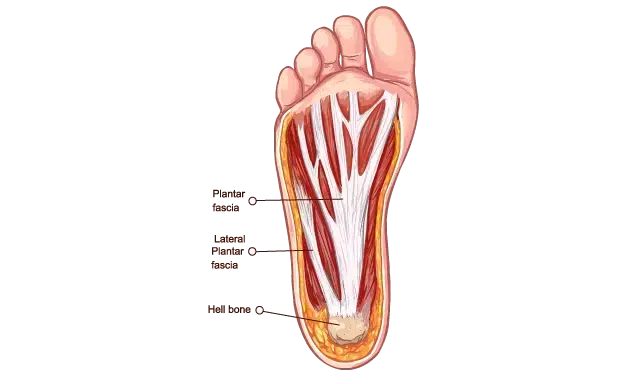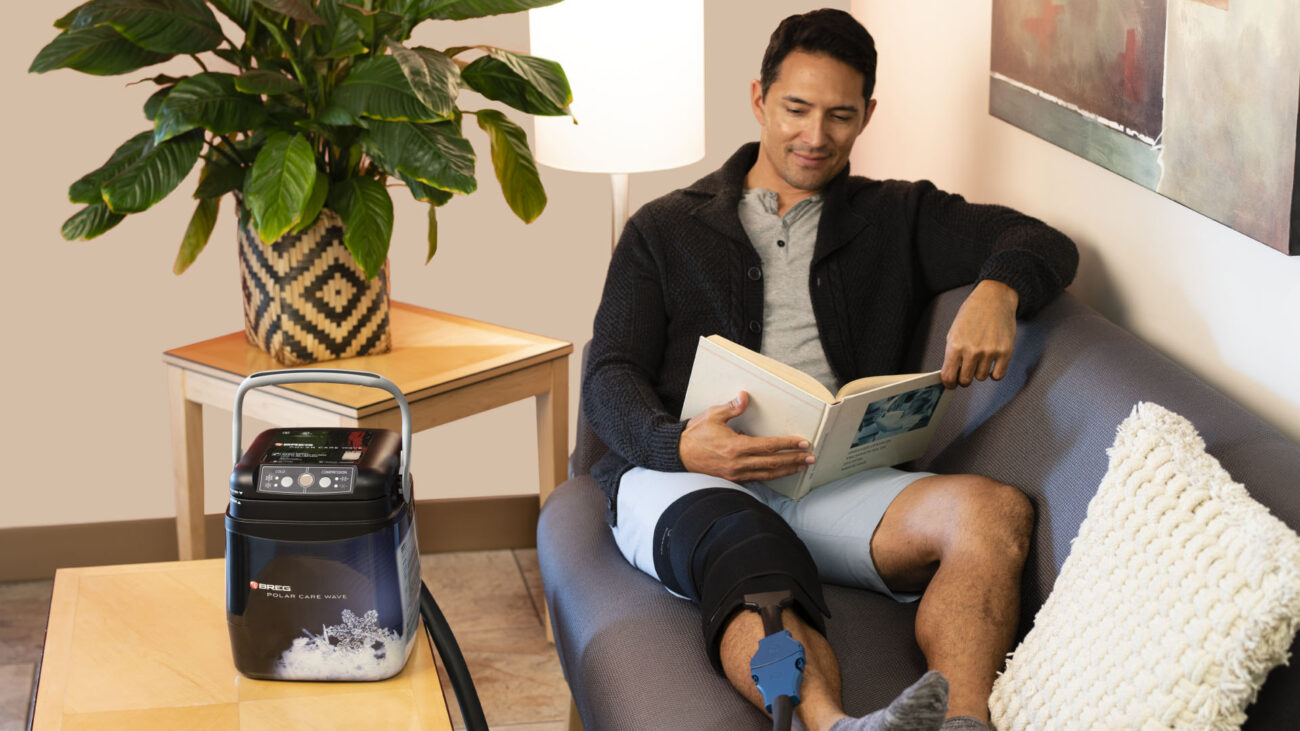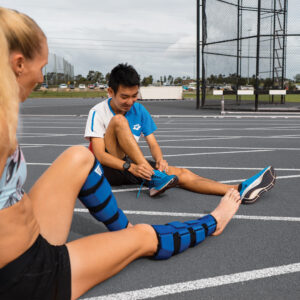Plantar fasciitis is marked by pain on the inside of the heel at the bottom of the foot and it usually starts slowly and builds over time. The pain is often described as a “throbbing” pain without numbness that is worsened with increased weight on the feet and going up and down stairs. The first few steps in the morning cause the worst pain.
The Plantar Fascia

What is the plantar fascia? The plantar fascia is a thick band running along the bottom of the foot
1. It starts from the heel and extends to the toes. The plantar fascia acts as a support and creates the arch of the foot. As we walk, the band tightens and helps to propel us forward through the windlass mechanism
2. It also helps with shock absorption
1,2. The plantar fascia consists of three bands, the medial, central and longitudinal. The medial band is the most likely source of pain in plantar fasciitis. Plantar fasciitis is a common cause of pain in the foot, up to 15% of all foot patients
1. Plantar fasciitis is marked by pain on the inside the heel at the bottom of the foot, which usually starts slowly and builds over time
3. Pain is often described as throbbing
4 without numbness and is worsened with weight on the feet and stairs. The pain is worst with the first few steps in the morning
5. This is due to the shortening of the plantar fascia as we sleep
5. This pain in the morning will gradually reduce as the tissues are stretched with movement.
What Causes Plantar Fasciitis?

Plantar fasciitis can be caused by excessively loading the tissues of the foot3. This may include extended time in standing, standing on hard surfaces, standing with unsupportive footwear, a sudden increase in walking/running or a change in walking/running surface2. Both high and low arches are related to the development of plantar fasciitis. Excess body weight has also been shown to increase the stress on the feet. Changes in the lower body’s movements are most strongly associated with plantar fasciitis, such as tight calves or hamstrings. These factors should be considered as they will need to be changed for a long-lasting resolution of pain.
Benefits of Exercise for Plantar Fasciitis
Exercise can be beneficial for managing and recovering from plantar fasciitis for several reasons:
- Strengthening the Affected Area: Specific exercises can target the muscles and tendons around the foot, ankle, and lower leg, helping to strengthen and support the plantar fascia, which is a thick band of tissue running along the sole of the foot.
- Improved Flexibility: Stretching exercises can enhance the flexibility of the calf muscles and the plantar fascia itself, which may reduce tension and strain on the inflamed tissue.
- Promoting Blood Flow: Gentle exercises encourage blood circulation to the affected area, aiding in the healing process by delivering essential nutrients and removing waste products.
- Reducing Pain and Discomfort: While exercising may cause temporary discomfort, it can lead to long-term relief by improving the condition and functionality of the plantar fascia.
- Preventing Stiffness: Regular movement and exercises can prevent the plantar fascia from becoming stiff and tight, which could aggravate the condition further.
- Maintaining Healthy Body Weight: Excess body weight can put extra strain on the feet and exacerbate plantar fasciitis. Engaging in exercises and maintaining a healthy weight can alleviate this pressure.
- Enhancing Range of Motion: Targeted exercises can help improve the range of motion in the foot and ankle, reducing the risk of re-injury and improving overall foot health.
- Correcting Gait Abnormalities: Some exercises may focus on correcting biomechanical issues that contribute to plantar fasciitis, such as overpronation or flat feet.
- Non-Invasive Approach: Exercise is generally a non-invasive and low-risk treatment option compared to more aggressive treatments, such as surgery or corticosteroid injections.
- Stress Relief and Mood Enhancement: Engaging in physical activity can release endorphins, which are natural mood boosters, helping to reduce stress and anxiety related to the injury.
- Long-term Prevention: Regular exercise and maintaining good foot health can reduce the likelihood of developing plantar fasciitis again in the future.
Exercises for Plantar Fasciitis

Plantar Fasciitis will commonly last for 12-18 months, with symptoms reducing after six weeks of treatment1. As mentioned in the last paragraph, the first treatment should be reducing the load on the tissues of the feet. This can be done through more supportive shoes and orthotics or reducing running/walking time. We then focus on stretching the plantar fascia, calf and hamstrings. Both muscles of the calf, the soleus and gastroc, should be stretched. This can be done through the bent knee and straight knee calf stretches (Advanced Stretching Program). We can also focus on releasing tight tissue in the plantar fascia and calves using a foam roller or hardball (Myofascial Release Exercises). Finally, functional strengthening should be introduced as the pain subsides.
These exercises focus on various ways of strengthening (eccentric and concentric) in different positions (standing, sitting). These exercises further focus stabilizing the lower leg and foot by strengthening the foot intrinsic muscles, Tibialis Anterior , Tibialis Posterior and the plantar fascia (Top 10 Strengthening Exercises). You can download these exercise free at the bottom of the blog.
About These Exercises
The Physio Store website does not provide specific medical or physiotherapy advice of any kind. All content on The Physio Store website including text, images, video, graphics, documents and other information, provided by The Physio Store Inc. does not constitute medical advice of any kind, and is not intended to be, and should not be, used to diagnose or identify treatment for a medical condition and may not be relied upon by you as medical or health care advice. You are advised to always seek the advice of a physician and/or qualified physiotherapist or other health practitioner in your area BEFORE taking any action, ordering or starting to use any product or exercises from our website.
The Physio Store Inc. is not responsible or liable for any failure to follow the foregoing advice.
References
1. Lim, A., How, C., & Tan, B. (2016). Management of plantar fasciitis in the outpatient setting. Singapore Medical Journal, 57(04), 168-171. doi: 10.11622/smedj.2016069
2. Martin, R. L., Davenport, T. E., Reischl, S. F., McPoil, T. G., Matheson, J. W., Wukich, D. K., … & Godges, J. J. (2014). Heel pain—plantar fasciitis: revision 2014. Journal of Orthopaedic & Sports Physical Therapy, 44(11), A1-A33.
3. Hasegawa, M., Urits, I., Orhurhu, V., Orhurhu, M. S., Brinkman, J., Giacomazzi, S., … & Viswanath, O. (2020). Current concepts of minimally invasive treatment options for plantar fasciitis: A comprehensive review. Current Pain and Headache Reports, 24(9), 1-11.
4. Johnson, R. E., Haas, K., Lindow, K., & Shields, R. (2014). Plantar fasciitis: what is the diagnosis and treatment?. Orthopaedic Nursing, 33(4), 198-204.
5. Cole, C., Seto, C. K., & Gazewood, J. D. (2005). Plantar fasciitis: evidence-based review of diagnosis and therapy. American family physician, 72(11), 2237-2242.
Download These Free Plantar Fasciitis Exercises
 Plantar Fasciitis Physiotherapy Based Exercise Program
Plantar Fasciitis Physiotherapy Based Exercise Program
 Advanced Stretching Program for Plantar Fasciitis
Advanced Stretching Program for Plantar Fasciitis
 Plantar Fasciitis Myofascial Release Exercise Program
Plantar Fasciitis Myofascial Release Exercise Program












 Ask A Question
Ask A Question
 Tax Exempt Shopping
Tax Exempt Shopping
 Get Clinical Pricing
Get Clinical Pricing
 Affiliate Program
Affiliate Program
 Retail Stores
Retail Stores
 Health Hub
Health Hub
 Shipping Policy
Shipping Policy
 Returns/Exchanges
Returns/Exchanges
 About Us
About Us
 Contact Us
Contact Us
 Login | Register
Login | Register




 BIOFLEX P120 Light Therapy System
BIOFLEX P120 Light Therapy System









